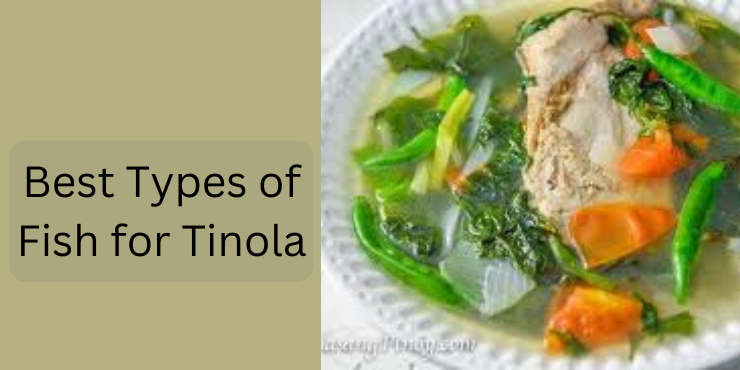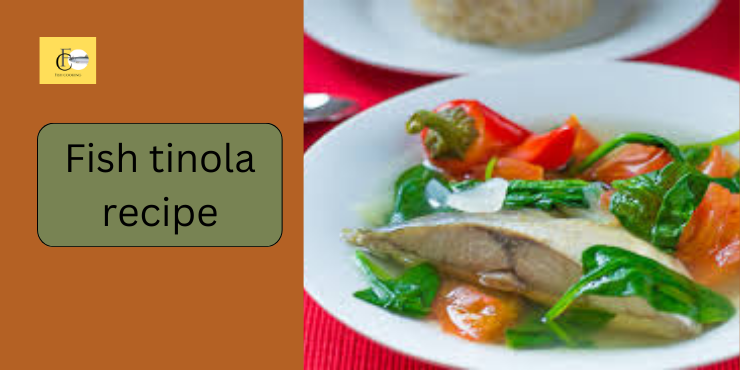Introduction
Fish Tinola Recipe is a delightful Filipino soup known for its light yet flavorful broth, tender fish, and fresh vegetables. This dish holds a special place in the hearts of many Filipinos due to its comforting taste and nutritional benefits. Often enjoyed as a warm meal during cooler months or as a hearty lunch, Fish Tinola is cherished for its simplicity and depth of flavor. If you’re looking to explore Filipino cuisine or simply want to try a new, wholesome soup recipe, Fish Tinola is an excellent choice.
Ingredients Needed for Fish Tinola Recipe
To make a delicious Fish Tinola, you’ll need the following ingredients:
Main Ingredients
- 1 lb of fish (preferably tilapia, milkfish, or any firm white fish)
- 1 medium green papaya, peeled and sliced
- 2 cups of malunggay leaves (or spinach as an alternative)
- 1 thumb-sized piece of ginger, sliced
- 1 medium onion, chopped
- 4 cloves of garlic, minced
- 4 cups of water or fish broth
- 2 tablespoons of fish sauce
- Salt and pepper to taste
Optional Ingredients
- Sili leaves (chili pepper leaves)
- 1 small green chili pepper
Using fresh ingredients is crucial for the best flavor, particularly the fish and vegetables, which are the stars of this dish.
Choosing the Right Fish
Best Types of Fish for Tinola

The best types of fish for Tinola are tilapia, milkfish (bangus), or any firm white fish like snapper or grouper. These types hold up well during cooking and provide a rich, satisfying taste.
Freshness Indicators
When choosing fish, look for clear eyes, bright red gills, firm flesh, and a fresh sea smell. Fresh fish will ensure a tastier and healthier Tinola.
Substitutes for Traditional Fish Types
If you can’t find tilapia or milkfish, you can substitute them with cod, haddock, or even salmon for a different flavor profile.
Preparing the Ingredients
Cleaning and Cutting the Fish
Start by cleaning the fish thoroughly under cold water. Remove the scales, innards, and fins if not already done. Cut the fish into serving-sized pieces, ensuring they are not too small to avoid them falling apart during cooking.
Prepping Vegetables and Spices
Peel and slice the green papaya into bite-sized pieces. Prepare the ginger by slicing it into thin pieces. Chop the onion and mince the garlic to release their flavors during cooking.
Step-by-Step Cooking Instructions
Step 1: Preparing the Broth
In a large pot, heat some oil over medium heat. Sauté the ginger, onion, and garlic until fragrant. This forms the aromatic base of your broth.
Step 2: Cooking the Fish
Add the water or fish broth to the pot and bring it to a boil. Reduce to a simmer, then add the fish pieces. Let the fish cook gently to infuse the broth with its flavor.
Step 3: Adding Vegetables and Spices
Once the fish is almost done, add the sliced green papaya and continue to simmer until the papaya is tender. Add the malunggay leaves (or spinach) and green chili pepper if using. Season with fish sauce, salt, and pepper to taste.
Step 4: Final Simmer and Seasoning
Let everything simmer together for a few more minutes to blend the flavors. Adjust the seasoning if necessary before turning off the heat.
Tips for Perfect Fish Tinola
Balancing Flavors
To achieve a well-balanced Tinola, make sure to taste the broth as you go. The fish sauce provides a salty umami flavor, while the ginger adds warmth.
Avoiding Overcooking the Fish
Fish cooks quickly, so keep an eye on it to prevent overcooking, which can make it tough. Add the fish when the broth is at a gentle simmer rather than a rolling boil.
Enhancing the Broth
For a richer broth, you can use fish stock instead of water or add a few shrimp shells during the initial boiling phase, then remove them before serving.
Common Mistakes to Avoid
Overcooking the Fish
Overcooking can result in dry, tough fish. Aim to cook it just until it’s opaque and flakes easily with a fork.
Using the Wrong Type of Fish
Avoid using delicate fish that can easily disintegrate. Stick to firmer varieties for the best results.
Over-Seasoning
Be cautious with the fish sauce and salt. It’s easier to add more seasoning later than to fix an overly salty dish.
Serving Suggestions
Traditional Serving Methods
Fish Tinola is typically served hot with steamed white rice on the side. The rice complements the flavorful broth perfectly.
Accompaniment and Side Dishes
Consider pairing Tinola with a simple salad or some grilled vegetables for a complete meal. A side of patis (fish sauce) with calamansi (Philippine lime) for dipping adds a zesty touch.
Presentation Tips
Serve Tinola in a deep bowl to showcase the colorful vegetables and pieces of fish. Garnish with a few fresh malunggay leaves for a pop of green.
Nutritional Benefits of Fish Tinola
Health Benefits of the Ingredients
Fish Tinola is not only delicious but also packed with nutrients. Fish provides high-quality protein and omega-3 fatty acids, which are good for heart health. The green papaya is rich in vitamins C and A, while malunggay leaves are a powerhouse of vitamins and minerals.
Nutritional Profile
A typical serving of Fish Tinola is low in calories and fat, making it an excellent choice for a healthy diet. It’s a well-balanced meal that provides essential nutrients without being heavy.
Variations of Fish Tinola
Regional Variations
Different regions in the Philippines might add unique ingredients to their Tinola. Some might use different leafy greens, or add a splash of coconut milk for a richer flavor.
Modern Twists on the Classic Recipe
Modern variations of Fish Tinola might include additional vegetables like carrots or bell peppers, or even use seafood like shrimp or squid instead of fish.
Storing and Reheating Fish Tinola
Proper Storage Techniques
Store any leftover Tinola in an airtight container in the refrigerator. It will keep well for up to three days.
Reheating Tips to Retain Flavor
When reheating, do so gently over low heat to avoid overcooking the fish. Add a bit of water or broth if the soup has thickened too much in the fridge.
Frequently Asked Questions (FAQs)
Can I use frozen fish for Tinola?
Yes, you can use frozen fish, but make sure to thaw it properly and pat it dry before cooking to avoid excess water diluting the broth.
What can I use as a substitute for malunggay leaves?
If malunggay leaves are unavailable, spinach or kale are great substitutes that provide similar nutritional benefits.
How long can I store leftover Tinola?
Leftover Tinola can be stored in the refrigerator for up to three days. Ensure it is kept in an airtight container.
Can I add other vegetables to my Tinola?
Absolutely! Feel free to add vegetables like carrots, bell peppers, or even zucchini to enhance the nutritional profile and flavor.
Is Fish Tinola suitable for a keto diet?
Yes, Fish Tinola can be suitable for a keto diet, especially if you omit the papaya or replace it with a low-carb vegetable.
Conclusion
Fish Tinola is a wonderful, comforting dish that’s easy to make and full of flavor. With its simple ingredients and straightforward cooking process, it’s a perfect recipe to try if you’re new to Filipino cuisine or simply looking for a nourishing meal. So why not give it a try? Your taste buds will thank you!
FAQs After Conclusion
Can I use shrimp instead of fish in Tinola?
Yes, shrimp can be a delicious substitute for fish. Just adjust the cooking time, as shrimp cooks faster than fish.
What other spices can I add to enhance the flavor?
You can experiment with adding lemongrass or even a splash of fish sauce with calamansi juice for an extra zesty kick.
How do I make the broth richer?
To make the broth richer, consider adding some shrimp shells during the initial boil or using a more concentrated fish stock.
What’s the best way to serve Tinola to guests?
Serve Tinola in individual bowls, garnished with fresh malunggay leaves and a side of steamed rice. A small dish of patis with calamansi makes a great accompaniment.
Are there any common allergens in Fish Tinola?
Fish Tinola contains fish, which is a common allergen. Always check with your guests for fish allergies before serving.

